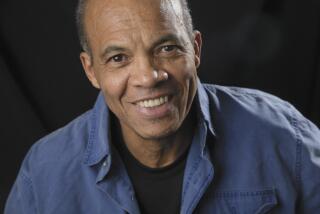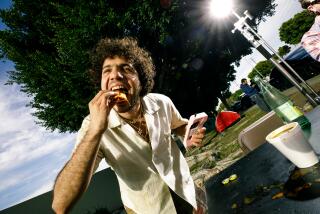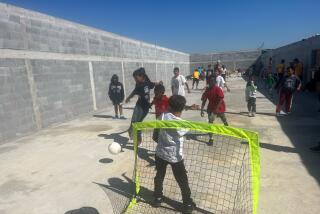Grabbing the Chance to Make a Difference in a Little Boy’s Life
He is a short kid, with a thatch of black hair over his eyes. He crouches cross-legged behind me here in the Beacon House office, mouthing gunfire and high-speed chase noises--the common coin of 6-year-old boys at solitary play who have more imagination than toys.
Salvador is a sort of mascot around the Beacon House, a residential alcohol recovery home overlooking the San Pedro waterfront, where I live.
A stretch of Beacon Street just below us--a onetime stronghold of brothels and bars--was once described by “Ripley’s Believe It or Not” as “The Toughest 10 Blocks in the World.”
Urban redevelopment’s big bucks and bulldozers have since changed things, but perhaps not that much.
Salvador is one of our many neighborhood kids. He isn’t a latchkey kid on this street of largely low-income families who occupy once-elegant Victorian mansions and bungalows. He lives with his mother, who works, an older brother and a teen-aged aunt. Other adults rent rooms in the old two-story house where he lives, and they too are around to look after children.
But something--perhaps the right type of role model--is missing. The Beacon House, which serves men 18 and older, with its dozens of surrogate big brothers, uncles and grandfathers, draws him almost daily.
His scrawled drawings decorate the office of executive director Mary Proper. Sometimes Savador eats lunch or dinner at the communal table here. One can’t forget his grin as he rode on the shoulders of a 6-foot-4 recovering alcoholic at our Cinco de Mayo celebration.
Toward dusk, young men of the neighborhood drift and swirl around Salvador’s house.
They’re the Rancho San Pedro Gang, and their RSP graffiti adorn fences and street corners. A few months ago someone was shot to death at a gang “truce” party, and now RSP graffiti is supplemented by “RIP Looney.” In August, drive-by shooters put a bullet into a wall of the gang’s hangout.
Salvador comes bouncing in the back door at Beacon House. “Do you drink beer?” he asks.
“What?”
“You drink beer?”
“Nope. That’s why I work here, Salvador. They teach me how to not drink beer. It isn’t cool for me to drink beer.”
“Yeah. You drink beer, and you get sick. You might die,” he declares. “Know what? I drink beer. But . . . I’m not gonna drink beer no more. No more, man. . . .”
The next day, Mary Proper has a new pair of Salvador’s original posters--made with felt-tip marker pens on pirated copying machine paper--on her office wall. One shows a female stick figure with the caption: “I Love Mary.”
The other depicts a glass with a large X marked through it and the caption: “Salvador Don’t Drink Beer No More.”
It seems the neighborhood gangbangers give the little boy beer when he hangs around their evening street-corner gatherings. Residents of a nearby large county board-and-care facility for the homeless and mentally handicapped also drink on the street. But we don’t think they would give alcohol to children.
“We gotta put a stop to this,” one of the Beacon House recovering alcoholics remarks.
No one here jokes about Salvador’s experiment with alcohol, the potion that claims so many men who perceive it manly and adult to use it.
Salvador isn’t around for a day or two. Then three small neighborhood girls come timidly to Beacon House. They push open the door to the dining room and shyly ask to see Mary.
They tell her that Salvador was drunk again the night before, lurching around the neighborhood, giggling and groaning.
They say Salvador had gotten the alcohol from the RSP gangbangers loitering around their corner.
“What was Salvador drinking? Do you know?” Mary Proper asks.
“It was wine coolers,” says a girl of about 9. “I know.”
And that’s what happens on our part of Beacon Street, the stretch once known as the toughest 10 blocks in the world.
Not all stories have unhappy endings, however, although only time will tell how the children of Beacon Street and environs turn out.
Salvador is running in and out of the Beacon House office one day as a new minister in the neighborhood, the Rev. Barbara Kilgore of First United Methodist Church, visits.
“Who is that little boy?” she asks.
Mary Proper explains.
“There must be something we could do for some of these little kids,” says Kilgore. Within an hour, the two women plan an after-school program at the church for children through junior high school.
A church-affiliated foundation made a $10,000 grant. Men from the Beacon House volunteer as unpaid staff. Mondays and Wednesdays they assist with creative arts, crafts, games and basketball in a gym behind the sanctuary.
Jim, a self-styled former “alcoholic dope fiend,” is teaching kids to compose haiku.
“Poems are for sissies,” scoffs a boy named Miguel, but soon he and the others are counting syllables and composing haiku. A little girl named Vasthi gets exactly 17 syllables on three lines in the traditional Japanese form. She describes a tree branch that Jim brought for inspiration.
“They lack confidence,” he says. “I hope in a few weeks they’ll learn there’s no right or wrong way to do this kind of thing.
“I hope I can teach them it’s OK to just to it, to write little poems about the beauty of life and the world around us.”
Today, Salvador is a card-carrying first-grader. He comes running into Beacon House to show off his new school ID card.
So far as we’ve heard, he has too much going to spend time hanging out on the corner with older boys.
He participates in the kids’ after-school program when he can get someone to escort him through the busy downtown streets of Old San Pedro.
“Salvador comes up to me as he gets home from school and says, ‘Come on,’ ” says Beacon House resident Don C., 56, a Korean War veteran now studying to be an electrician.
Don, who once won $25,000 in the California Lottery and partied it all away, walks down the street toward the church with Salvador.
More to Read
Sign up for Essential California
The most important California stories and recommendations in your inbox every morning.
You may occasionally receive promotional content from the Los Angeles Times.









